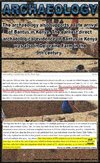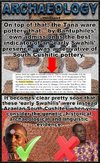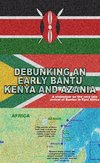I usually don't post about anything past the Bronze Age, but a recent thread here reminded me of a large Twitter account some friends and I went to e-war with and the larger question of why the actual heck orientalists hate our guts. There's so much lost because unfortunately one of us got sick of defending Somali history (blame qabiilists who undone all of our combined 100+ hours of researching and posting) and deactivated his account. I also moved on and focused on prehistory because there's no way to argue that muh Punt is Darood history only or some bullshit. Actually LOOL I do remember getting dunked on for trying to post about Laas Geel because it's Somaliland history only a few years ago but anyways....
Typically when dealing with orientalism it's all about Adal and Ethiopianist revisionism. The Twitter account in question however is world-renowned Swahiliphile @Rhaplord (probably portmanteau of Rhapta and lord - he's Ugandan so probably sees them as self-insert); he's one of the biggest African history accounts (for good reason, his other stuff is really quite decent, not the greatest of writers tho) and constantly makes attempts to Swahili-wash the history of South Somalia's biggest cities.
He has umpteen posts where he explicitly states the origins were Swahili, but the best was his long blogpost on Muqdisho. You'll get the gist from the screenshot below:


What surprised us most is that all of the conjecture was supported by commentary by an obscure historian from the 70s-90s where they totally misrepresent the first-hand accounts. We made a quite long thread where we found the primary sources of every claim he made, and some more to support the alternative hypothesis, and dunked on him. All three of us held blocks by the end of the day. It's really quite sinister.
Read the thread by clicking here. I'm still quite proud of the thread, though of course the writing isn't the best in some tweets. We couldn't be bothered to proofread we wanted to dunk same day. I have most of his stuff archived for any of his old followers do let me know if you want me to post any other things.
So many other examples. Another that comes to mind is the Mwalimu Ibrame tweet, where for no good reason, he, using the idea that pre-Yaquubi Muqdisho was Swahili, see here:

... to suggest that a Ma'alin Ibrahim was akshully called Mwalimu Ibrame.... cos Mwalimu is uniquely Swahili apparently. I quite literally have an uncle called Macalin Ibrahim so it made it all the funnier. We found the primary source after way too much digging cos we knew for a fact it was cap, and would you look at that?


The question remains though: how the actual helly hellion are people able to put together such bullshit and still have it be, to normies, well-sourced and credible? Why are there so many slander pieces on Somali history? @Idilinaa interested to hear what you have to say after ur input on the thread in question.
Typically when dealing with orientalism it's all about Adal and Ethiopianist revisionism. The Twitter account in question however is world-renowned Swahiliphile @Rhaplord (probably portmanteau of Rhapta and lord - he's Ugandan so probably sees them as self-insert); he's one of the biggest African history accounts (for good reason, his other stuff is really quite decent, not the greatest of writers tho) and constantly makes attempts to Swahili-wash the history of South Somalia's biggest cities.
He has umpteen posts where he explicitly states the origins were Swahili, but the best was his long blogpost on Muqdisho. You'll get the gist from the screenshot below:
What surprised us most is that all of the conjecture was supported by commentary by an obscure historian from the 70s-90s where they totally misrepresent the first-hand accounts. We made a quite long thread where we found the primary sources of every claim he made, and some more to support the alternative hypothesis, and dunked on him. All three of us held blocks by the end of the day. It's really quite sinister.
Read the thread by clicking here. I'm still quite proud of the thread, though of course the writing isn't the best in some tweets. We couldn't be bothered to proofread we wanted to dunk same day. I have most of his stuff archived for any of his old followers do let me know if you want me to post any other things.
So many other examples. Another that comes to mind is the Mwalimu Ibrame tweet, where for no good reason, he, using the idea that pre-Yaquubi Muqdisho was Swahili, see here:
... to suggest that a Ma'alin Ibrahim was akshully called Mwalimu Ibrame.... cos Mwalimu is uniquely Swahili apparently. I quite literally have an uncle called Macalin Ibrahim so it made it all the funnier. We found the primary source after way too much digging cos we knew for a fact it was cap, and would you look at that?
The question remains though: how the actual helly hellion are people able to put together such bullshit and still have it be, to normies, well-sourced and credible? Why are there so many slander pieces on Somali history? @Idilinaa interested to hear what you have to say after ur input on the thread in question.





